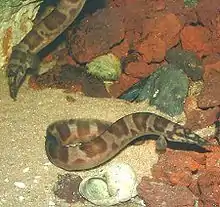Mastacembelus ellipsifer
Mastacembelus ellipsifer is a species of spiny eel that is endemic to Lake Tanganyika in Africa and sometimes kept in aquariums. Although sometimes called the Tanganyikan spiny eel,[3] it is only one of fifteen spiny eel species in the Tanganyikan basin (fourteen endemic).[4][5]
| Mastacembelus ellipsifer | |
|---|---|
 | |
| Scientific classification | |
| Kingdom: | Animalia |
| Phylum: | Chordata |
| Class: | Actinopterygii |
| Order: | Synbranchiformes |
| Family: | Mastacembelidae |
| Genus: | Mastacembelus |
| Species: | M. ellipsifer |
| Binomial name | |
| Mastacembelus ellipsifer Boulenger, 1899 | |
| Synonyms[2] | |
| |
Description
The eel is up to 45 centimeters (18 in) long. The color is brownish-beige with a ring-shaped dark brown pattern. The dorsal fins are hard.[3] The fish is endemic to Lake Tanganyika and can commonly be found along the shores of the lake. It can commonly be found in intermediate zones.[3] The eels prefer coastal waters with a sandy, rock, or a muddy bottom. The species environment is benthopelagic freshwater.[2] The eels eat small fish in the wild. The species is nocturnal.[3] Human uses for this eel are fisheries and aquariums. The eel is listed as Least Concern on the IUCN Red List.[2] It was one of the species that was photographed as part of a FishBase mission which had the primary objective to document and photograph the rich fish diversity of Lake Tanganyika with the help of ichthyologist Dr. Tyson R. Roberts.[6]
Aquarium
In captivity, they eat small animals such as prawn, cockle, mussel, earthworms,[3] shrimp,[7] and bloodworm. The aquarium needs piles of rocks for sheltered areas. The base of the tank needs to be covered in sand; gravel should not be used because it can damage the eel's skin. If there is light, it should be dim.[3] The temperature of the water needs to be 73–81 °F (23–27 °C), the pH in the range 8.0–9.5, and the hardness 8–25°H.[3] Breeding has occurred in tanks. The tank size needs to be 88 US gallons (330 l; 73 imp gal).[7]
The species might cohabit with other species that are too large for it to eat.[3] However, it can be aggressive to other species and might require more space.[7]
References
- Bigirimana, C. & Vreven, E. (2006). "Mastacembelus ellipsifer". IUCN Red List of Threatened Species. 2006: e.T60389A12348870. doi:10.2305/IUCN.UK.2006.RLTS.T60389A12348870.en.
- Froese, Rainer and Pauly, Daniel, eds. (2006). "Mastacembelus ellipsifer" in FishBase. Augustyear=2019 2006 version.
- "Mastacembelus ellipsifer - Tanganyikan Spiny Eel". Seriously Fish. Retrieved 2010-06-07.
- Brown; Rüber; Bills; Day (2010). "Mastacembelid eels support Lake Tanganyika as an evolutionary hotspot of diversification". BMC Evolutionary Biology. 10: 188. doi:10.1186/1471-2148-10-188. PMC 2903574. PMID 20565906.
- Brown; Britz; Bills; Rüber; Day (2011). "Pectoral fin loss in the Mastacembelidae: a new species from Lake Tanganyika". Journal of Zoology. 284 (4): 286–293. doi:10.1111/j.1469-7998.2011.00804.x.
- "Lake Tanganyika: Kigoma, Tanzania and Mpulungu, Zambia". FishBase. Retrieved 2010-06-07.
- "Aethiomastacembelus ellipsiferA". African Cichlids. Retrieved 2010-06-07.

